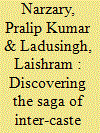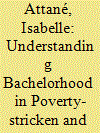| Srl | Item |
| 1 |
ID:
167118


|
|
|
|
|
| Summary/Abstract |
In India marrying across the caste kindles strong community resentment, leading to the extent of honor killing, yet few couples dare to defy this stringent social norm. Analysis of large-scale survey (India Human Development Survey 2011–12) data exhibits an inconsequential rise in this social incongruity since 1951 to attain 4.5% in 2012. It is most prevalent in the northeastern region (11.6%), but least prevalent in caste-ridden central India (1.8%). Multi-variate statistics exhibit that if women are allowed to choose their life-partner, caste takes a rear-seat in marriage contemplation. It is quite prominent among the women who selected the husband by themselves and knew the husband at least one year before the marriage. Contrary to general notion, education is not able to promote inter-caste marriage. Odds of inter-caste marriage taking place in Dalit (lowest social standing) households is much lesser than the higher caste. Resilient targeted efforts are necessary to promote inter-caste marriage, which may loosen the noose of the caste system in India.
|
|
|
|
|
|
|
|
|
|
|
|
|
|
|
|
| 2 |
ID:
085022


|
|
|
|
|
| Publication |
2008.
|
| Summary/Abstract |
Examining patterns of mate selection and the core issue of agency, this brief article reports on fieldwork in a remote community in Pakistan, where the family continues to have supervening influence over individual choices in mate selection through exchange marriages. It explores the role of the family as a security provider and demonstrates the limited scope for individual agency. The behaviour of the family in mate selection, where strong security concerns are observed, indicates a culture-centered approach to tackle the issue in a clan context, where members try to maximise various aspects of security in the exchange of mate relations. Intensive fieldwork indicates significant feelings of insecurity among individuals over spouse selection and adoption of family-centered choices. Often the families of this agrarian community give priority to exchange marriages of their offspring, leaving limited options for the evasion of family control, since social security concerns normally prevail. The article also considers briefly the wider implications of such research.
|
|
|
|
|
|
|
|
|
|
|
|
|
|
|
|
| 3 |
ID:
169794


|
|
|
|
|
| Summary/Abstract |
Coupled with the social practice of female hypergamy, the male surplus within the never-married population means that today's Chinese marriage market is extremely tight in particular for men from a rural background and the least privileged socio-economic categories. Drawing on quantitative data from a survey conducted in 2014–2015, this article sheds light on the situation of single men who are past prime marriage age in three rural districts of Shaanxi particularly affected by this phenomenon. It compares single men's characteristics to those of their married counterparts and offers insights into the heterogeneity of single men with the aim of challenging some commonly accepted assumptions about bachelorhood in rural China. Results suggest a strong internalization of the various characteristics, centred on being able to offer social mobility to a potential wife, that a man is expected to have to be attractive to women in a context where women have more choice in mate selection. We conclude that mate selection is highly marked by class, social norms, social interactions, health, generation and age, and requires the mobilization of certain amounts of individual, social and economic resources. Unwanted bachelorhood would thus be better understood using an intersectional approach rather than mainly in numeric terms.
|
|
|
|
|
|
|
|
|
|
|
|
|
|
|
|